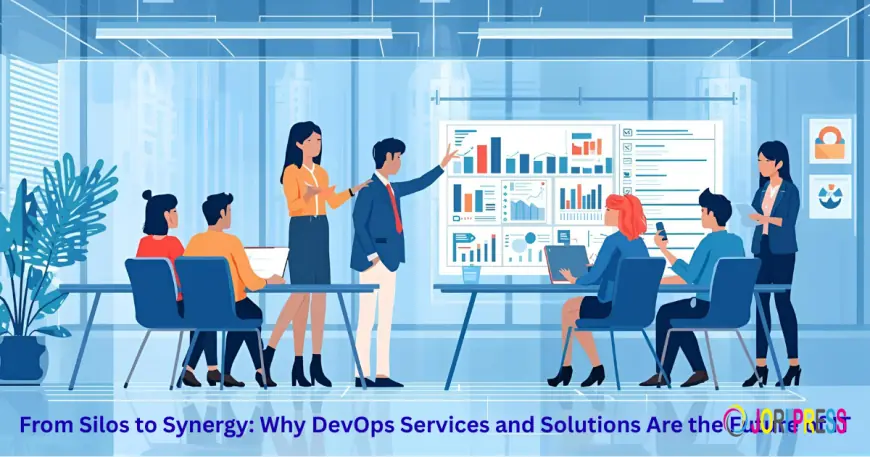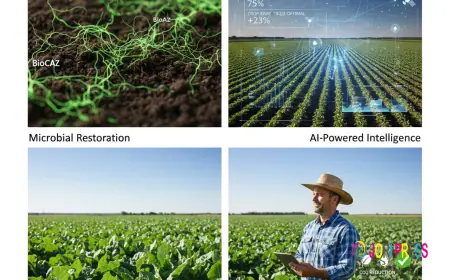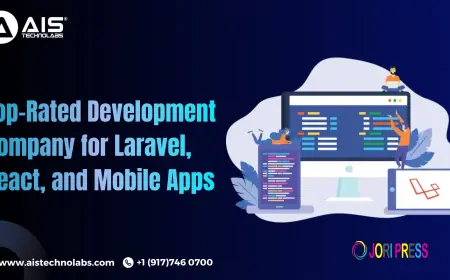From Silos to Synergy: Why DevOps Services and Solutions Are the Future of IT
Discover how DevOps Services Future drives IT transformation, breaking silos and creating synergy for faster, efficient, and innovative operations.

Modern IT departments face a constant battle between innovation and stability. Developers want to introduce new features rapidly, while operations teams prioritize reliability and security. This conflict creates silos — isolated departments working independently, often with limited communication or shared objectives.
These silos lead to delays, misalignment, and wasted resources. The result? Slower releases, more errors, and frustrated teams.
DevOps Services and Solutions bridge this divide. DevOps integrates software development (Dev) and IT operations (Ops) into a seamless, automated, and collaborative framework. The focus shifts from “my task” to “our goal” — delivering value to end users efficiently and continuously.
By breaking down organizational barriers, DevOps fosters synergy, agility, and innovation — key ingredients for businesses navigating digital transformation.
According to Puppet’s 2024 State of DevOps Report, high-performing DevOps organizations deploy code 208 times more frequently, with 106x faster lead times and 7x lower failure rates than traditional IT setups.
Understanding the Concept of DevOps
At its core, DevOps represents a cultural, procedural, and technological shift in how IT systems are managed and software is delivered.
It’s not just about tools or automation — it’s about mindset. DevOps encourages cross-functional collaboration between developers, testers, operations staff, and even business stakeholders.
Key Objectives of DevOps Services and Solutions:
-
Faster Delivery: Streamline software releases through automation.
-
Improved Collaboration: Encourage shared ownership and communication.
-
Continuous Feedback: Use data-driven insights to refine processes.
-
Enhanced Quality: Integrate testing and monitoring early in development.
-
Customer-Centricity: Deliver updates that directly respond to user needs.
This approach enables continuous integration (CI) — where code is merged frequently — and continuous delivery (CD), ensuring new features are released swiftly and safely.
The Evolution from Silos to Synergy
Before DevOps, the traditional Waterfall model dominated software development. In this linear approach:
-
Developers built the product.
-
QA tested it afterward.
-
Operations deployed and maintained it post-launch.
Each team had different objectives and rarely communicated effectively. When an issue arose, blame-shifting often replaced collaboration.
Agile methodology improved this by promoting iterative development and customer feedback, but Agile alone wasn’t enough — it didn’t extend beyond development into operations.
DevOps took Agile principles further by integrating the entire software lifecycle — from planning and coding to testing, deployment, and monitoring.
Now, with DevOps, IT organizations operate as collaborative ecosystems where all departments share responsibility for performance, uptime, and user satisfaction. This shift from isolation (silos) to integration (synergy) has redefined the essence of modern IT.
Core Principles of DevOps Services and Solutions
Successful DevOps implementation depends on several guiding principles:
1. Collaboration and Communication
DevOps breaks barriers between teams, encouraging constant communication and feedback. Shared goals ensure that developers, testers, and operations professionals work cohesively, reducing conflicts and duplication of effort.
2. Automation
Automation lies at the heart of DevOps. From code builds to infrastructure provisioning and deployment, automation ensures consistency, reduces human errors, and accelerates delivery.
3. Continuous Integration and Continuous Delivery (CI/CD)
This principle allows code to be integrated, tested, and deployed continuously. CI/CD pipelines ensure early bug detection, smoother releases, and quicker delivery to end users.
4. Infrastructure as Code (IaC)
IaC treats infrastructure setup as software — using code to configure servers, databases, and networks. This approach provides scalability, repeatability, and version control for infrastructure.
5. Monitoring and Feedback
Continuous monitoring provides insights into system performance, enabling proactive maintenance. Feedback loops help refine applications based on real-world performance data.
Each of these principles contributes to greater agility, efficiency, and reliability across IT operations.
Key Components That Make DevOps Successful
A successful DevOps ecosystem involves integration across various tools and technologies.
1. Source Code Management (SCM)
Tools like Git, GitHub, and Bitbucket manage version control, allowing teams to collaborate on code efficiently. SCM ensures every code change is tracked and reversible.
2. Continuous Integration Tools
Platforms like Jenkins, GitLab CI, and CircleCI automate code builds, testing, and integration. This eliminates manual intervention, ensuring each update is verified before deployment.
3. Containerization and Orchestration
Docker standardizes environments by packaging applications into containers. Kubernetes orchestrates these containers, ensuring consistent deployment across different infrastructures.
4. Configuration Management
Tools such as Ansible, Chef, and Puppet automate server configurations, reducing manual errors and ensuring consistent environments across production and testing stages.
5. Monitoring and Logging
Solutions like Prometheus, Grafana, and ELK Stack (Elasticsearch, Logstash, Kibana) provide real-time system insights and help quickly identify performance bottlenecks.
6. Collaboration Platforms
DevOps thrives on communication. Tools like Slack, Jira, and Trello support transparency, task tracking, and streamlined workflows.
Business Benefits of Adopting DevOps Services and Solutions
1. Accelerated Time-to-Market
With CI/CD automation, software can be deployed in minutes instead of weeks. This enables rapid adaptation to customer demands and competitive markets.
2. Enhanced Collaboration
Breaking silos fosters mutual understanding between developers and operations, promoting faster problem resolution and innovation.
3. Increased Customer Satisfaction
Frequent, reliable updates improve user experience and trust. Fewer bugs and faster response times lead to stronger customer loyalty.
4. Cost Optimization
Automation and efficient resource utilization reduce waste, manual labor, and downtime — cutting operational costs significantly.
5. Competitive Advantage
Companies using DevOps can adapt to market trends quicker, giving them a significant edge in product innovation and service delivery.
Accelerate State of DevOps 2024 Report shows that businesses using DevOps principles experience 60% higher customer satisfaction and 30% faster revenue growth compared to those using traditional IT models.
Technical Advantages That Transform IT Operations
1. Scalable Cloud Infrastructure
DevOps seamlessly integrates with cloud platforms like AWS, Azure, and Google Cloud, providing scalability, flexibility, and cost efficiency.
2. Automated Testing and Deployment
Automation tools handle repetitive tasks, ensuring faster deployments and reducing human errors, resulting in consistent quality across releases.
3. Enhanced Security (DevSecOps)
Security is integrated early in the development pipeline. Continuous vulnerability scanning, automated patching, and compliance checks enhance data protection.
4. Version Control and Rollback
Versioning enables teams to revert to previous builds easily, minimizing downtime in case of production issues.
5. Proactive Monitoring
Real-time metrics provide visibility into performance, enabling faster incident response and system optimization.
Together, these technical benefits lead to greater system stability, higher efficiency, and reliable digital services.
Real-World Applications of DevOps Across Industries
|
Industry |
Application of DevOps |
Key Benefits |
|
Finance |
Continuous deployment of secure apps |
Faster feature delivery and improved compliance |
|
Healthcare |
Automating testing of patient data systems |
Enhanced reliability and data protection |
|
E-commerce |
Rapid A/B testing and real-time analytics |
Improved UX and higher conversion rates |
|
Automotive |
Integration with connected vehicle platforms |
Faster OTA updates and predictive maintenance |
|
Telecom |
Network monitoring and automation |
Improved service uptime and faster rollout |
Across sectors, DevOps Services and Solutions enable faster innovation, stable operations, and stronger compliance frameworks.
Challenges in DevOps Implementation and How to Overcome Them
1. Cultural Resistance
Teams accustomed to traditional workflows may resist change.
Solution: Introduce DevOps gradually with leadership support and team training.
2. Complex Toolchain
Managing multiple DevOps tools can become overwhelming.
Solution: Opt for integrated platforms like GitLab or Atlassian that combine CI/CD, monitoring, and collaboration.
3. Security Concerns
Faster releases can risk compliance lapses.
Solution: Incorporate DevSecOps — embedding security within CI/CD pipelines.
4. Lack of Expertise
DevOps demands skilled engineers proficient in automation, cloud, and coding.
Solution: Partner with a reliable DevOps Services and Solutions provider for strategy and implementation support.
5. Measuring ROI
Organizations often struggle to quantify DevOps success.
Solution: Track key KPIs such as deployment frequency, failure rate, and recovery time to demonstrate value.
The Role of Cloud, Automation, and AI in Modern DevOps
Modern DevOps thrives on the synergy between three technologies:
1. Cloud Computing
Cloud-native DevOps simplifies deployment, resource allocation, and scalability.
Public, private, and hybrid cloud setups ensure on-demand infrastructure that aligns with business needs.
2. Automation
Automation tools streamline CI/CD pipelines, configuration, testing, and deployment — accelerating delivery while minimizing manual workload.
3. Artificial Intelligence and Machine Learning
AI-powered analytics predict failures, detect anomalies, and optimize workloads automatically.
For instance, AIOps (AI for IT Operations) enhances monitoring and decision-making accuracy.
These innovations make DevOps smarter, faster, and more efficient — ensuring IT ecosystems evolve continuously.
Measuring Success with DevOps Metrics and KPIs
Tracking performance through the right metrics validates DevOps success:
|
KPI |
Description |
|
Deployment Frequency |
How often new releases are deployed. Higher = more agile. |
|
Lead Time for Changes |
Time from code commit to production. Lower = faster delivery. |
|
Change Failure Rate |
Percentage of failed deployments. Lower = higher quality. |
|
Mean Time to Recovery (MTTR) |
Time to recover from incidents. Lower = more resilient system. |
|
System Uptime |
Percentage of time services remain operational. Higher = better reliability. |
By analyzing these KPIs, organizations can continuously optimize performance and delivery.
Why DevOps Services and Solutions Are the Future of IT
As digital ecosystems become more dynamic, traditional IT structures can’t keep up with rapid technological evolution.
DevOps Services and Solutions provide the agility and resilience needed for:
-
Rapid innovation cycles
-
Reduced downtime
-
Continuous user-centric improvement
-
Scalable infrastructure management
-
Secure and compliant delivery pipelines
In essence, DevOps is no longer a luxury but a necessity — a cultural revolution shaping the future of IT. Businesses that embrace DevOps will lead through innovation, efficiency, and adaptability.
How to Choose the Right DevOps Partner
Selecting the right DevOps service provider is crucial for success. Consider:
-
Experience & Expertise — Proven track record with CI/CD, cloud integration, and automation tools.
-
Tool Proficiency — Familiarity with leading platforms like Jenkins, Docker, and Terraform.
-
Customized Strategy — Tailored DevOps roadmap aligned with your business goals.
-
Security Focus — Experience with DevSecOps and compliance management.
-
Post-Implementation Support — Continuous monitoring and optimization after deployment.
Partnering with a skilled DevOps consulting company ensures smooth adoption and maximum return on investment.
Conclusion
The transition from silos to synergy is more than just an operational change — it’s a cultural revolution in IT.
DevOps Services and Solutions bring together the best of development, operations, and automation to create a cohesive ecosystem of innovation. By uniting people, processes, and technology, DevOps ensures faster delivery, improved collaboration, and long-term business growth.
As automation, AI, and cloud technologies continue to evolve, DevOps will remain the driving force behind IT transformation — making businesses more adaptive, scalable, and future-ready.
FAQs
Q1. How do DevOps Services and Solutions improve collaboration?
They align development, testing, and operations teams under shared goals using automation and feedback loops, enhancing communication and accountability.
Q2. Is DevOps suitable for non-technical businesses?
Yes. Even non-tech industries like healthcare, finance, and manufacturing benefit from DevOps through automation, faster delivery, and improved quality assurance.
Q3. What are the top DevOps tools for 2025?
Popular tools include Jenkins, Docker, Kubernetes, Terraform, GitLab, Ansible, and Prometheus.
Q4. What is the role of security in DevOps?
Security is integrated into every stage through DevSecOps, ensuring vulnerabilities are identified and resolved early.
Q5. How can a DevOps Services provider help my organization?
A professional provider offers consulting, automation setup, CI/CD implementation, cloud integration, and 24/7 monitoring to ensure smooth digital operations.
What's Your Reaction?
 Like
0
Like
0
 Dislike
0
Dislike
0
 Love
0
Love
0
 Funny
0
Funny
0
 Angry
0
Angry
0
 Sad
0
Sad
0
 Wow
0
Wow
0















































